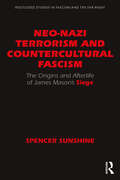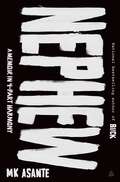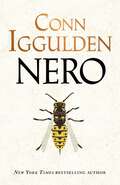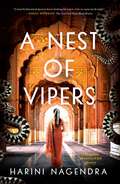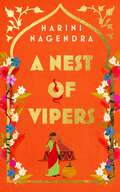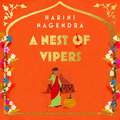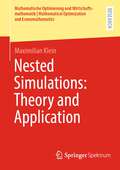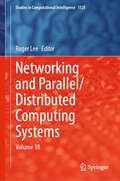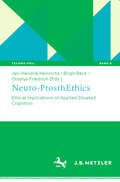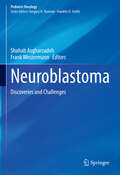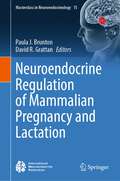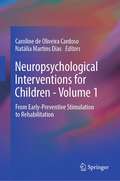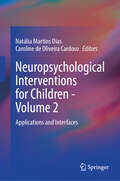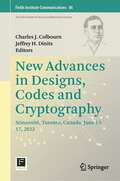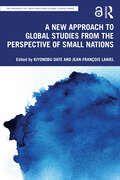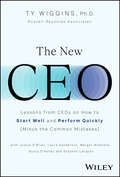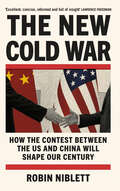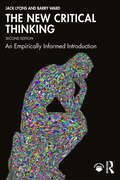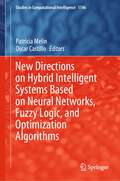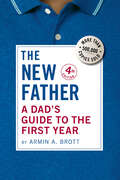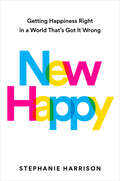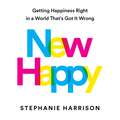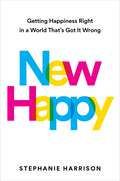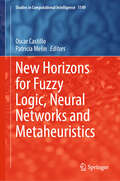- Table View
- List View
Neo-Nazi Terrorism and Countercultural Fascism: The Origins and Afterlife of James Mason’s Siege (Routledge Studies in Fascism and the Far Right)
by Spencer SunshineA new wave of aspiring neo-Nazi terrorists has arisen—including the infamous Atomwaffen Division. And they have a bible: James Mason’s Siege, which praises terrorism, serial killers, and Charles Manson. Neo-Nazi Terrorism and Countercultural Fascism, based on years of archival work and interviews, documents for the first time the origins of Siege.First, it shows how Mason’s vision arose from debates by 1970s neo-Nazis who splintered off the American Nazi Party/National Socialist White People's Party and spun off a terrorist faction. Second, it unveils how four 1980s countercultural figures—musicians Boyd Rice and Michael Moynihan, Feral House publisher Adam Parfrey, and Satanist Nikolas Schreck—discovered, promoted, and published Mason. Neo-Nazi Terrorism and Countercultural Fascism explores a previously overlooked period and unearths the hidden connections between a countercultural clique and violent neo-Nazis—which together have set the template for today’s Neo-nazi terrorist underground.It is obligatory reading for those interested in contemporary terrorism, postwar countercultures, and the history of the U.S. Far Right and neo-Nazism.
Nephew: A Memoir in 4-Part Harmony
by M.K. AsanteAs urgent, resonant, and essential as The Fire Next Time and Between the World and Me, a poetic, raw, and inspirational love letter from the bestselling author of Buck, written to a nephew who was shot nine times and survived—a reflection on life, overcoming odds, finding your voice, and the power of music and family.Waiting in the emergency room at Temple University Hospital in North Philadelphia where his eighteen-year-old nephew, Nasir, lay unconscious after being shot nine times, MK Asante began pouring his heart and soul into a series of letters to a beautiful, dying Black boy so full of life.As Nasir fought for survival, MK realized there was so much—too much—that he had kept from his nephew, starting with the truth about his father, MK’s brother, Uzi, whom Nasir had never met. MK could no longer remain silent because in many ways, his nephew was repeating the mistakes of the past. MK began his confessional to repair family bonds—to save Nasir from the same streets that stole his father and to introduce him to the man and family history the young man had never known. The result is this beautiful, poignant, and honest family memoir.Nephew introduces us to two men, strangers to each other, whose similarities are astonishing. Both have red hot tempers, both struggle with opioid addiction, and most profoundly, both are lyrical geniuses whose raps are raw, powerful, and autobiographical. Yet neither had ever heard the other’s lyrics. As he tells his family’s story, MK draws vivid portraits of both Nasir and Uzi through their songs—lyrics that become the touchstone of their relationship. When father and son eventually meet, they confront each other and share a dialogue through their lyrics.An explosive, innovative memoir of family, faith, poetry, secrets, love, race, poverty, redemption, addiction, Philadelphia, hip-hop, jail, purpose, mental health, and violence. Nephew is fast-paced, intimate, lyrical, educational, and inspirational. It is the epic, painful, poetic, and miraculous redemptive story of a new generation—a new style of memoir for a new decade, the rhythmic story of a family in love, struggle, and verse.
Nero: A Novel (The Nero Trilogy)
by Conn IgguldenFrom this New York Times bestselling author, the first novel in a new trilogy that finds Empress Agrippina and her young son, Nero, fending off ambitious rivals while shaping their own destiny—if Nero is to become the most feared and notorious emperor of them all.The story begins with a hand curled around another man&’s throat. This is Roman justice: Emperor Tiberius first dispatches a traitor—a friend he once trusted with the city—then the man's whole family and all of his friends. It is as if he never existed. Into this fevered forum, a child is born. His mother is Agrippina, granddaughter of Emperor Augustus. But their imperial blood is neither balm nor protection. Rather, it is a liability. Blood is easily spilled or poisoned. So swiftly corrupted. As the aging, paranoid Tiberius becomes blind to the ignoble end awaiting him, Agrippina sees the future. Her once-exiled brother Caligula is next in succession, which brings her another step closer to the heart of the empire—to power, ambition, and danger. Every day she will face soldiers, senators, rivals, silver-tongued pretenders, each vying for position. One mistake risks exile, incarceration, execution. Or, worst of all, perhaps the loss of her infant son. Because Agrippina knows that, even in your darkest moments, opportunity rises. Her son is everything. She can make this boy, shape him into Rome itself—the man before whom all must kneel. But first, Agrippina and Nero must survive . . .
A Nest of Vipers: A Bangalore Detectives Mystery (Bangalore Detectives Club)
by Harini NagendraThe latest novel in the award-winning Bangalore Detectives Club series finds amateur sleuth Kaveri Murthy involved in a dangerous plot that endangers the life of the visiting Prince of Wales.This latest novel in the Bangalore Detectives Club mystery series takes the reader deep into the historical era surrounding the visit by Edward, Prince of Wales, to Bangalore in 1921. When the prince begins a tour of a number of Indian cities, he encounters passionate crowds demanding independence from Britain, with rioting on the streets of Bombay in November 1921. The mood of the prince's subsequent trip to Bangalore and Mysore in January 1922 appears, at first glance, very different and is made to large, welcoming crowds. But perhaps all is not what it seems to be. While exploring another (seemingly unrelated) crime scene, Kaveri and Ramu become tangled in a complex web of intrigue, getting pulled into a potentially dangerous plan that could endanger the life of the visiting prince. This new novel also takes us into the world of jadoo—Indian street magic—with sleight-of-hand magicians, snake charmers, and rope tricks. Kaveri and Ramu continue their sleuthing, with help from the Bangalore Detectives Club, amidst the growing rumblings of Indian independence and the backdrop of female emancipation.
A Nest of Vipers: A Bangalore Detectives Club Mystery (The Bangalore Detectives Club Series)
by Harini Nagendra'Deliciously exotic' Sunday Post'A beautifully painted picture of a woman's life in 1920s India' M W CRAVEN----Death stalks the streets of Bangalore when the Circus comes to town . . .January 1922.The Bangalore Constabulary is on high alert as The Prince of Wales is scheduled to visit the city to redeem his reputation after disastrous visits marked by violent anti-British riots.Kaveri has none of these concerns on her mind, not when she has just been given VIP tickets to the famous Bangalore circus. But when a celebrity magician, shackled in an iron cage filled with deadly snakes, disappears into thin air, she is stunned to discover her friend and favourite policeman, Inspector Ismail, is telling her to leave the case well alone.After solving two murder cases, Kaveri Murthy thought she had cemented her reputation as Bangalore's favourite lady detective. But when death threats are left at her doorstep, former friends become foes, and the bodies start to pile up, Kaveri realises she has never been in this much danger . . .PRAISE FOR HARINI NAGENDRA'A gorgeous debut mystery with a charming and fearless sleuth . . . spellbinding' SUJATA MASSEY'Told with real warmth and wit. . . A perfect read for fans of Alexander McCall Smith and Vaseem Khan' - ABIR MUKHERJEE'A cosy mystery that warmly illuminates a time and place not often examined in fiction' VASEEM KHAN'A beautifully painted picture of a woman's life in 1920s India' M W CRAVEN'A delight' CATRIONA MCPHERSON'The classic whodunnit with the added appeal of a female sleuth in Colonial India. . . fascinating' RHYS BOWEN'Riveting . . . A fine start to a promising series' BOOKLIST Starred Review'I couldn't put it down' VICTORIA THOMPSON, USA Today bestselling author of Murder on Madison Square'Absolutely charming . . . this one is a winner!' CONNIE BERRY, USA Today best-selling and Agatha-nominated author of The Kate Hamilton Mysteries.'An enjoyable trip back in time with a spunky young woman for company.' R V RAMAN, author of Fraudster and A Will to Kill'This lush mystery will transport you to heady 1920s Bangalore . . . Mouth-watering fashion and food set against simmering colonial intrigue in this delicious whodunit can be devoured in one sitting.' SUMI HAHN, author of The Mermaid from Jeju'I loved The Bangalore Detectives Club . . . Kaveri especially is charming.' OVIDIA YU, author of The Cannonball Tree Mystery'Nagendra makes her fiction debut with an exceptional series launch. . . rich, edifying, and authentic' Publishers Weekly, Starred Review
A Nest of Vipers: A Bangalore Detectives Club Mystery (The Bangalore Detectives Club Series)
by Harini Nagendra'Deliciously exotic' Sunday Post'A beautifully painted picture of a woman's life in 1920s India' M W CRAVEN----Death stalks the streets of Bangalore when the Circus comes to town . . .January 1922.The Bangalore Constabulary is on high alert as The Prince of Wales is scheduled to visit the city to redeem his reputation after disastrous visits marked by violent anti-British riots.Kaveri has none of these concerns on her mind, not when she has just been given VIP tickets to the famous Bangalore circus. But when a celebrity magician, shackled in an iron cage filled with deadly snakes, disappears into thin air, she is stunned to discover her friend and favourite policeman, Inspector Ismail, is telling her to leave the case well alone.After solving two murder cases, Kaveri Murthy thought she had cemented her reputation as Bangalore's favourite lady detective. But when death threats are left at her doorstep, former friends become foes, and the bodies start to pile up, Kaveri realises she has never been in this much danger . . .PRAISE FOR HARINI NAGENDRA'A gorgeous debut mystery with a charming and fearless sleuth . . . spellbinding' SUJATA MASSEY'Told with real warmth and wit. . . A perfect read for fans of Alexander McCall Smith and Vaseem Khan' - ABIR MUKHERJEE'A cosy mystery that warmly illuminates a time and place not often examined in fiction' VASEEM KHAN'A beautifully painted picture of a woman's life in 1920s India' M W CRAVEN'A delight' CATRIONA MCPHERSON'The classic whodunnit with the added appeal of a female sleuth in Colonial India. . . fascinating' RHYS BOWEN'Riveting . . . A fine start to a promising series' BOOKLIST Starred Review'I couldn't put it down' VICTORIA THOMPSON, USA Today bestselling author of Murder on Madison Square'Absolutely charming . . . this one is a winner!' CONNIE BERRY, USA Today best-selling and Agatha-nominated author of The Kate Hamilton Mysteries.'An enjoyable trip back in time with a spunky young woman for company.' R V RAMAN, author of Fraudster and A Will to Kill'This lush mystery will transport you to heady 1920s Bangalore . . . Mouth-watering fashion and food set against simmering colonial intrigue in this delicious whodunit can be devoured in one sitting.' SUMI HAHN, author of The Mermaid from Jeju'I loved The Bangalore Detectives Club . . . Kaveri especially is charming.' OVIDIA YU, author of The Cannonball Tree Mystery'Nagendra makes her fiction debut with an exceptional series launch. . . rich, edifying, and authentic' Publishers Weekly, Starred Review
A Nest of Vipers: A Bangalore Detectives Club Mystery (The Bangalore Detectives Club Series)
by Harini Nagendra'Deliciously exotic' Sunday Post'A beautifully painted picture of a woman's life in 1920s India' M W CRAVEN----Death stalks the streets of Bangalore when the Circus comes to town . . .January 1922.The Bangalore Constabulary is on high alert as The Prince of Wales is scheduled to visit the city to redeem his reputation after disastrous visits marked by violent anti-British riots.Kaveri has none of these concerns on her mind, not when she has just been given VIP tickets to the famous Bangalore circus. But when a celebrity magician, shackled in an iron cage filled with deadly snakes, disappears into thin air, she is stunned to discover her friend and favourite policeman, Inspector Ismail, is telling her to leave the case well alone.After solving two murder cases, Kaveri Murthy thought she had cemented her reputation as Bangalore's favourite lady detective. But when death threats are left at her doorstep, former friends become foes, and the bodies start to pile up, Kaveri realises she has never been in this much danger . . .PRAISE FOR HARINI NAGENDRA'A gorgeous debut mystery with a charming and fearless sleuth . . . spellbinding' SUJATA MASSEY'Told with real warmth and wit. . . A perfect read for fans of Alexander McCall Smith and Vaseem Khan' - ABIR MUKHERJEE'A cosy mystery that warmly illuminates a time and place not often examined in fiction' VASEEM KHAN'A beautifully painted picture of a woman's life in 1920s India' M W CRAVEN'A delight' CATRIONA MCPHERSON'The classic whodunnit with the added appeal of a female sleuth in Colonial India. . . fascinating' RHYS BOWEN'Riveting . . . A fine start to a promising series' BOOKLIST Starred Review'I couldn't put it down' VICTORIA THOMPSON, USA Today bestselling author of Murder on Madison Square'Absolutely charming . . . this one is a winner!' CONNIE BERRY, USA Today best-selling and Agatha-nominated author of The Kate Hamilton Mysteries.'An enjoyable trip back in time with a spunky young woman for company.' R V RAMAN, author of Fraudster and A Will to Kill'This lush mystery will transport you to heady 1920s Bangalore . . . Mouth-watering fashion and food set against simmering colonial intrigue in this delicious whodunit can be devoured in one sitting.' SUMI HAHN, author of The Mermaid from Jeju'I loved The Bangalore Detectives Club . . . Kaveri especially is charming.' OVIDIA YU, author of The Cannonball Tree Mystery'Nagendra makes her fiction debut with an exceptional series launch. . . rich, edifying, and authentic' Publishers Weekly, Starred Review
Nested Simulations: Theory and Application (Mathematische Optimierung und Wirtschaftsmathematik | Mathematical Optimization and Economathematics)
by Maximilian KleinMaximilian Klein analyses nested Monte Carlo simulations for the approximation of conditional expected values. Thereby, the book deals with two general risk functional classes for conditional expected values, on the one hand the class of moment-based estimators (notable examples are the probability of a large loss or the lower partial moments) and on the other hand the class of quantile-based estimators. For both functional classes, the almost sure convergence of the respective estimator is proven and the underlying convergence speed is quantified. In particular, the class of quantile-based estimators has important practical consequences especially for life insurance companies since the Value-at-Risk falls into this class and thus covers the solvency capital requirement problem. Furthermore, a novel non parametric confidence interval method for quantiles is presented which takes the additional noise of the inner simulation into account.
Networking and Parallel/Distributed Computing Systems: Volume 18 (Studies in Computational Intelligence #1125)
by Roger LeeThe book reports state-of-the-art results in Software Engineering, Artificial Intelligence, Networking, and Parallel/Distributed Computing in both printed and electronic form. This book presents original papers on both theory and practice that address foundations, state-of-the-art problems and solutions, and crucial challenges.
Neuro-ProsthEthics: Ethical Implications of Applied Situated Cognition (Techno:Phil – Aktuelle Herausforderungen der Technikphilosophie #9)
by Jan-Hendrik Heinrichs Birgit Beck Orsolya FriedrichThe volume focusses on the ethical dimensions of the technological scaffold embedding human thought and action, which has been brought to attention of the cognitive sciences by situated cognition theories. There is a broad spectrum of technologies co-realising or enabling and enhancing human cognition and action, which vary in the degree of bodily integration, interactivity, adaptation processes, of reliance and indispensability etc. This technological scaffold of human cognition and action evolves rapidly. Some changes are continuous, some are eruptive. Technologies that use machine learning e.g. could represent a qualitative leap in the technological scaffolding of human cognition and actions. The ethical consequences of applying situated cognition theories to practical cases had yet to find adequate attention and are elucidated in this volume.
Neuroblastoma: Discoveries and Challenges (Pediatric Oncology)
by Shahab Asgharzadeh Frank WestermannThis book provides a state-of-the-art review of the biology, treatment, and other critical aspects of neuroblastoma, reflecting the dramatic advances that have been achieved in understanding and management. Topics are arranged according to the book’s dominant themes of the “seed” (tumor genomics, epigenetics, metabolism, and stem cells) and the “soil” (tumor microenvironment, adaptive and innate immunity, and exosomes) and how both of these influences can serve as rich targets for intervention, whether by targeted molecular therapy or immunotherapy. Therapeutic strategies that are currently in use or under consideration for the future are discussed in detail, with the focus on precision medicine. Further individual chapters are devoted to the biology and genetics of relapsed/refractory neuroblastoma and emerging methods of evaluating tumor burden. Finally, in keeping with the, albeit modest, increase in cure rates in high-risk disease, immune and cellular therapies are reviewed. This coverage of what is becoming a not-so-enigmatic tumor will appeal to a broad readership including both experimental oncologists and clinicians who care for patients with neuroblastoma.
Neuroendocrine Regulation of Mammalian Pregnancy and Lactation (Masterclass in Neuroendocrinology #15)
by David R. Grattan Paula J. BruntonAdaptations to maternal physiology are required for a successful pregnancy outcome. These changes are primarily orchestrated by the mother’s brain and involve multiple neuroendocrine systems. For this book, the editors have gathered internationally recognized experts who have contributed to the major advances in our understanding of different aspects of the neuroendocrine regulation of mammalian pregnancy and lactation. The book begins with a discussion of how pregnancy is recognized and maintained and the role of the placental hormones in supporting key adaptations required for a successful pregnancy. The next few chapters focus on the neuroendocrine adaptations that occur during pregnancy in some key regulatory processes to ensure a sufficient supply of energy and nutrients, protect the fetus from potentially harmful maternal stress hormones, and prepare mammals for birth, milk production, lactation and motherhood. Finally, our current understanding of how the significant peripartum hormonal changes contribute to the mother’s cognitive function and mood is examined. This book provides a broad overview of the finely orchestrated neuroendocrine adaptations that occur in pregnancy and lactation and discusses how such changes contribute to maximizing the likelihood of a positive outcome for mother and infant. Importantly the evidence for involvement of neuroendocrine dysregulation in some pregnancy-related complications, such as preterm birth and perinatal mood disorders is also highlighted. In addition to addressing fundamental mechanisms in the regulation of mammalian pregnancy and lactation, the book includes the most recent advances in the field made possible by utilizing the latest innovative research technologies. Moreover, it provides opinions on optimal experimental approaches, relates findings from experimental animal models with those from humans, and outlines the direction and opportunities for future research in this arena. It is an essential resource for undergraduate students, postgraduate students, and early career researchers embarking upon their journey in the fields of neuroendocrinology, endocrinology, reproductive biology or behavioural neuroscience. It also provides a valuable synopsis for established neuroendocrine researchers and educators, especially those whose interest transcends the nexus between neuroendocrinology and reproductive biology. This is the 15th volume in the International Neuroendocrine Federation (INF) “Masterclass in Neuroendocrinology” series, which aims to illustrate the highest standards and to encourage the use of the latest technologies in basic research and hopes to provide inspiration for further exploration into the exciting field of neuroendocrinology.
Neuropsychological Interventions for Children - Volume 1: From Early-Preventive Stimulation to Rehabilitation
by Caroline de Oliveira Cardoso Natália Martins DiasThis book is the first of two volumes that aim to serve as a comprehensive guide for professionals working with neuropsychological interventions especially designed for children. This first volume presents the theoretical foundations, tips and guidelines for neuropsychologists to develop different interventions, such as stimulation and early intervention with a focus on promoting neuropsychological health; habilitation, appropriate for work with neurodevelopment disorders; and rehabilitation, in cases of structural alterations. In this sense, it reflects the editors' concern to provide material with practical tips, but theoretically grounded, and truly useful to professionals in clinical and also school contexts. This first volume is divided into two parts. The first addresses the theoretical and practical foundations of child neuropsychological assessment and intervention. Neuropsychological assessment is discussed, with a focus on its role in guiding intervention. Also, different types of interventions are presented, and a taxonomy is offered, according to its differential objectives of promotion or remediation and the target population (typical development, functional or structural alterations of the Nervous System), leading to the suggestion of three types of interventions in neuropsychology in both clinical and school contexts: 1) Early preventive Intervention; 2) Habilitation and 3) Rehabilitation. Cognitive stimulation in different contexts, such as school, family and clinical, is also discussed, exploring how teachers and parents can also collaborate in intervention processes, expanding the possibilities for action beyond the clinical context. A section concludes by addressing the importance of the feedback and the neuropsychological assessment report.The second part focuses specifically on stimulation and rehabilitation, offering chapters that target specific skills such as attention, memory, executive functions and academic skills, among others. The chapters summarize evidence, bring tips and illustrate existing materials and programs, in a continuous articulation between theory-evidence-practice. Originally published in Portuguese and now available in English, Neuropsychological Interventions for Children – Volumes 1 and 2 will be of interest to professionals working with neuropsychology in clinical and school contexts. It will also be useful in neuropsychology teaching contexts (specialization courses in neuropsychology and related areas) and for students and professionals in interface areas, such as Psychology, Education, Speech Therapy, Occupational Therapy among others. The translation of the original Portuguese version of this book into English was done with the help of artificial intelligence. A subsequent human revision was done primarily in terms of content.
Neuropsychological Interventions for Children - Volume 2: Applications and Interfaces
by Caroline de Oliveira Cardoso Natália Martins DiasThis book is the second of two volumes that aim to serve as a comprehensive guide for professionals working with neuropsychological interventions especially designed for children. This second volume complements the theoretical and practical foundations presented in the first volume by presenting applications to different clinical conditions and by exploring interfaces of neuropsychology with other areas of research and practice. Chapters in this second volume are divided into two parts. The first part presents a series of case studies, illustrating the practice and experience of neuropsychological rehabilitation and habilitation in different clinical conditions. The second part brings together chapters that discuss the interfaces of neuropsychology with different areas, which can use its knowledge and interventions (such as school neuropsychology) or which can be used as strategies within neuropsychological intervention or even compose inter and transdisciplinary partnerships in the work of promotion, stimulation, or cognitive remediation, such as the use and role of music, games and play, mindfulness, and transcranial direct current stimulation. So, chapters in this second part highlight the interfaces with other approaches, knowledges or disciplines. Originally published in Portuguese and now available in English, Neuropsychological Interventions for Children – Volumes 1 and 2 will be of interest to professionals working with neuropsychology in clinical and school contexts. It will also be useful in neuropsychology teaching contexts (specialization courses in neuropsychology and related areas) and for students and professionals in interface areas, such as Psychology, Education, Speech Therapy, Occupational Therapy among others. The translation of the original Portuguese version of this book into English was done with the help of artificial intelligence. A subsequent human revision was done primarily in terms of content.
New Advances in Designs, Codes and Cryptography: Stinson66, Toronto, Canada, June 13-17, 2022 (Fields Institute Communications #86)
by Charles J. Colbourn Jeffrey H. DinitzThis volume records and disseminates selected papers from the Stinson66 conference, including surveys, prospectives, and papers presenting original and current research. It contains four accessible surveys of topics in combinatorial designs and related topics, ranging from a tutorial survey of connections to classical group theory, to surveys of "hot topics" in current research. It also contains a prospective paper identifying topics for future research efforts, co-authored by one of the elder statesmen of the field, Alex Rosa. Finally, the research papers examine topics ranging from pure mathematics to applied work in computing, networking, communications, and cryptography. For students and newcomers to these topics, the volume provides accessible survey material that does not have onerous prerequisites. The breadth of topics reflects the vibrancy of the field in a way that can be appreciated by all researchers. The papers present important advances on theory and applications,which also benefit advanced researchers.
A New Approach to Global Studies from the Perspective of Small Nations (The University of Tokyo-Routledge Global Studies Series)
by Kiyonobu Date Jean-François LanielWith emphasis on East Asian and North American examples – notably Japan and Quebec – Date, Laniel and their contributors take a new approach to the understanding of small nations and their role in the international system. Small nations, by their very nature, raise significant questions about what a nation is. Some small nations are sovereign states with relatively small populations and limited territory, others are nations within larger sovereign states, with distinctive cultures, governance structures or other features that differentiate them from their “parent” state. By focussing on non-European nations in particular, the contributors to this volume challenge our conceptions of what a small nation is and how it operates within the international system. They focus in particular on the nation-within-a-nation-state of Quebec and on Japan, supplemented by further examples from East Asia. By interrogating what these examples have to show us about the typology and character of small nations, they offer a critique of superpower and draw out the potential of small nation studies. A valuable resource for students and scholars of international relations and theories of the nation and nation state.
The New CEO: Lessons from CEOs on How to Start Well and Perform Quickly (Minus the Common Mistakes)
by Ty WigginsYour personal guide to navigating the first days, weeks, and months in the top job, based on powerful interviews with today's most successful CEOs. Becoming a CEO is a high-stakes moment, whether it's your first, second, or third time in the seat. What you say and how you act in your early days as CEO sets the tone for how you'll be perceived for years to come. Yet, until now, few CEOs have shared their stories on what worked, what didn't, and what they wish they'd done differently. In The New CEO, Dr. Ty Wiggins, an experienced leadership advisor specializing in CEO transitions, explains how to land well as a new CEO, accelerate your impact, and unlock the most affirming experience of your career. Drawing on compelling storytelling and groundbreaking research of hundreds of CEOs around the world, the book offers a incisive guide on what to say and do as a new CEO, including how to define your priorities, build your team, fast-track critical changes, work with the board, and set (or reset) the organization's culture. You'll also find: Why being a CEO is the toughest (and loneliest) job in business—and what to do about it. How to overcome the “First 100 Days” mindset and pressure for early wins to deliver sustainable, long-term success. How to avoid getting trapped in the “CEO Bubble,” as well as how to navigate (inevitable) challenges, knocks, and missteps. Perfect for newly appointed CEOs—whether it's your first time on the job or your second or third—The New CEO is also an essential resource for anyone seeking insights into the mindset and priorities of CEOs, including board members and directors, in-house counsel, leadership coaches, other executives, and consultants.
The New Cold War: How the Contest Between the US and China Will Shape Our Century
by Robin NiblettAn urgent and essential assessment of the global contest between the US and China, and how looking to history will help us to navigate it, from former Director of Chatham House"An illuminating book for the interested citizen as well as for those making policy" - Hillary Rodham Clinton We have entered a new Cold War. The contest between America and China is global and unbridgeable, and it encompasses all major instruments of statecraft - economic, political and military. It has its tinder box: Taiwan. And both protagonists are working hard to draw allies to their side from across the world. We stand at its beginning. But this Cold War is nothing like the conflict between the Soviet Union and the West which defined the second half of the twentieth century. We need new ideas to navigate its risks and avoid a globally devastating hot war. In this urgent and necessary book, Robin Niblett argues that only by looking back can we learn the lessons to guide us through this new reality: he goes through the ten ways in which the New Cold War is different and offers five rules for navigating its onset. How we manage this contest will determine not only whether there is still space for international cooperation to deal with our many global challenges, from the climate emergency to the technological revolution, but also who will lead the twenty-first century and, quite simply, the course of all our futures.
The New Critical Thinking: An Empirically Informed Introduction
by Jack Lyons Barry WardThis book aims to improve real-world critical thinking.Traditional critical thinking texts neglect two crucial facts. First, as psychologists have shown, many of our mistakes are caused not by faulty formal reasoning but because we bypass it in favor of intuitive, often unreliable heuristics. Second, good critical thinking requires not only the proper assessment of inference but also of our premises: the evaluation of information sources is of fundamental importance, especially in this internet era of fake news and politicized science.This highly innovative text is psychologically informed, both in its diagnosis of inferential errors and in teaching students how to watch out for, and circumnavigate, their natural intellectual blind spots. It also incorporates insights from epistemology and philosophy of science to formulate best practices for assessing information sources on the internet and other media. The result is a practical, hands-on primer for real-world critical thinking.The authors bring more than five combined decades of classroom experience to the subject, covering the usual core topics of deductive, inductive, causal, and probabilistic inference, argument identification, reconstruction, and diagramming, while also extending the text’s scope to include testimony, the nature and credibility of science, rhetoric, and dialectical argumentation.The Second Edition further develops and refines these innovations, combining in-depth discussion of “fake news” and conspiracy theories with exercises and projects designed to teach broadly applicable source assessment skills. There is also a more nuanced positive account of science that emphasizes its continuity with commonsense causal reasoning. For instructors, there are additional online resources, notably banks of exam questions with solutions and various class projects.Key Features: Uses contemporary psychological explanations and remedies for pervasive errors in belief formation. No other critical thinking text generally applies this psychological approach Rigorously addresses the evaluation of premises based on testimony, in particular the testimony of internet sources Carefully explains the concept of validity, paying particular attention to distinguishing logical possibility from other species of possibility Uses frequency trees as a simple and reliable alternative to more complicated Bayesian methods Uses arguments maps, which improve students’ reasoning and argument evaluation Key Updates to the Second Edition: Expanded discussion of the psychology of reasoning and belief, including treatment of motivated reasoning Uses a conventional truth-table–based approach to propositional logic while incorporating a more intuitive, psychologically informed approach to the logic of conditionals New Summary Boxes Enhanced treatment of testimony, with an expanded discussion of fake news, conspiracy theories, and the application of general epistemic principles to navigate the extremes of gullibility and unmotivated skepticism. New exercises that emphasize practical, hands-on source assessment skills An improved discussion of the nature of science emphasizing the central role of causal inference and the multi-generational, cumulative character of scientific knowledge A new Index of Arguments, summarizing the most common argument forms and associated defeaters for the inductive forms New online content, including exams and additional questions (plus solutions), suitable for upload to course management software (e.g., Blackboard, etc.) For online resources suitable for students and instructors, please see the appropriate link on the book’s Routledge web page: www.routledge.com/9781032317281
New Directions on Hybrid Intelligent Systems Based on Neural Networks, Fuzzy Logic, and Optimization Algorithms (Studies in Computational Intelligence #1146)
by Patricia Melin Oscar CastilloThis book contains a collection of papers focused on hybrid intelligent systems based on soft computing techniques. In this book, new directions on the theoretical developments of fuzzy logic, neural networks and optimization algorithms, as well as their hybrid combinations, are offered. In addition, the abovementioned methods are discussed in application areas such as control and robotics, pattern recognition, medical diagnosis, decision-making, prediction and optimization of complex problems. There are a group of papers with the main theme of type-1, type-2 and type-3 fuzzy logic, which basically consists of papers that propose new concepts and algorithms based on type-1, type-2 and type-3 fuzzy logic and their applications. There is also a set of papers that offer theoretical concepts and applications of meta-heuristics in different areas. Another group of papers outlines diverse applications of hybrid intelligent systems in real problems. There are also some papers that presenttheory and practice of neural networks in different applications. Finally, there are papers that offer theory and practice of optimization and evolutionary algorithms in different application areas
The New Father: A Dad's Guide To The First Year (The New Father #0)
by Armin A. BrottThe best-selling guide to the first year of fatherhood, trusted by hundreds of thousands of new dads and their partners This indispensable handbook, from the author of the million-selling Expectant Father, provides a reassuring month-by-month overview of your baby’s first year. It covers the milestones in your child’s development; ways you can bond with your child and support your partner; and what’s going on with you, as a new dad. The fourth edition of The New Father features a user-friendly new design and is updated from cover to cover with the latest information about healthcare, financial planning, parental leave and work-life balance, and much more. It incorporates the expertise of leading pediatricians and researchers, and the real-life experiences of hundreds of dads and moms. Illustrated with stress-relieving cartoons, The New Father is a friendly, readable, and inclusive companion for all new dads. (Moms will love it, too!)
New Happy: Getting Happiness Right in a World That's Got It Wrong
by Stephanie HarrisonA NEXT BIG IDEA CLUB MUST-READ Well-being expert and social media sensation Stephanie Harrison of @newhappyco reveals the counterintuitive secrets to happiness and provides a practical guide to help us all learn how to live a happy life.We all want to be happy, but happiness always seems to be out of reach — until now. In New Happy, happiness expert Stephanie Harrison draws upon hundreds of studies to offer a life-changing guide to finding the happiness you have been looking for, all based on a decade of research and brought to life with beautiful artwork. It&’s not your fault if you are unhappy. You have been told three lies: you&’re not good enough; you need to achieve fame, wealth, and power; and you need to do it all on your own. This is Old Happy, our society&’s false definition of happiness, and it&’s making us miserable. In this book, you&’ll learn the truth: you are enough, you have unique and important gifts, and using them to help other people leads to your happiness. New Happy is your step-by-step guide to building the life you want. Accompanied by revelatory artwork that explains key concepts, Harrison takes you through the process of unwinding Old Happy, uncovering your own gifts, and using them to both improve your life and the world at the same time. If you have ever asked yourself, &“Who am I really?&” &“When will I be happy?&” or &“What am I supposed to do with my life?&” this book is for you.Through an inspiring blend of art and science, New Happy will forever change the way that you see yourself and the world. Whether you&’re wondering what career you should choose, navigating a life transition, going through a difficult time, teaching your kids what matters most, or simply hoping to experience more joy every day, New Happy offers the proven path to a happier life and a better world.
New Happy: Getting Happiness Right in a World That's Got It Wrong
by Stephanie HarrisonWe all want to be happy. This goal drives everything that we do. Why, then, are so many of us so unhappy? It's not your fault. You have been told a lie: that achieving your own success will make you happy. This is "old happy," society's incorrect definition of happiness.The truth is that happiness comes from helping other people to live happier lives. Accompanied by revelatory artwork that explains key concepts, New Happy takes you through the process of unwinding Old Happy, uncovering your own gifts, and using them to both improve your life and the world at the same time. If you have ever asked yourself, "Who am I really?" "When will I be happy?" or "What am I supposed to do with my life?" this book is for you.Through an inspiring blend of art and science, New Happy will forever change the way that you see yourself and the world. Whether you're wondering what career you should choose, navigating a life transition, going through a difficult time, teaching your kids what matters most, or simply hoping to experience more joy every day, New Happy offers the proven path to a happier life and a better world.
New Happy: Getting Happiness Right in a World That's Got It Wrong
by Stephanie HarrisonWe all want to be happy. This goal drives everything that we do. Why, then, are so many of us so unhappy? It's not your fault. You have been told a lie: that achieving your own success will make you happy. This is "old happy," society's incorrect definition of happiness.The truth is that happiness comes from helping other people to live happier lives. Accompanied by revelatory artwork that explains key concepts, New Happy takes you through the process of unwinding Old Happy, uncovering your own gifts, and using them to both improve your life and the world at the same time. If you have ever asked yourself, "Who am I really?" "When will I be happy?" or "What am I supposed to do with my life?" this book is for you.Through an inspiring blend of art and science, New Happy will forever change the way that you see yourself and the world. Whether you're wondering what career you should choose, navigating a life transition, going through a difficult time, teaching your kids what matters most, or simply hoping to experience more joy every day, New Happy offers the proven path to a happier life and a better world.
New Horizons for Fuzzy Logic, Neural Networks and Metaheuristics (Studies in Computational Intelligence #1149)
by Oscar Castillo Patricia MelinThis book contains a collection of papers focused on hybrid intelligent systems based on soft computing techniques. In this book, new horizons on the theoretical developments of fuzzy logic, neural networks and optimization algorithms are envisioned. In addition, the abovementioned methods are discussed in application areas such as control and robotics, pattern recognition, medical diagnosis, decision-making, prediction and optimization of complex problems. There are a group of papers with the main theme of type-1, type-2 and type-3 fuzzy systems, which basically consists of papers that propose new concepts and algorithms based on type-1, type-2 and type-3 fuzzy logic and their applications. There is also a group of papers that offer theoretical concepts and applications of meta-heuristics in different areas. Another group of papers outlines diverse applications of hybrid intelligent systems in real problems. There are also a group papers that present theory and practice of neural networks in different applications. Finally, there are papers that offer theory and practice of optimization and evolutionary algorithms in different application areas.
